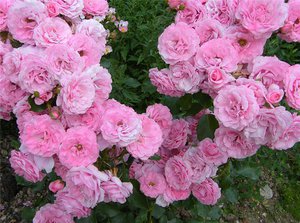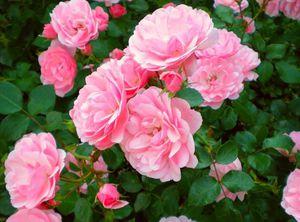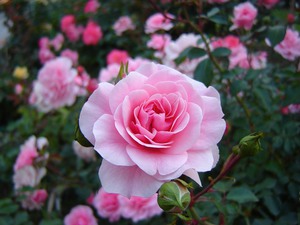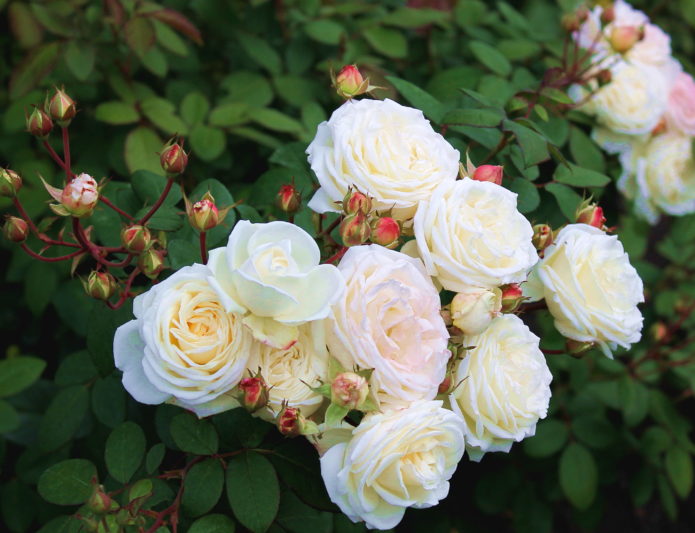Most people cannot help but admire a beautiful garden and gorgeous flowers in it. Of course, the rose has always been very popular with gardeners. The bonika rose, which will be discussed below, was bred not so long ago: only in 1985. However, for already 3 dozen it pleases flower lovers around the world.
Rose bonika: plant description
As mentioned above, bonika is a relatively young flower. It is surprising that she immediately took root and immediately became the darling of summer residents. What is the reason for this? First, the bonika rose is strong, very bright and profusely flowering plant... Secondly, the bonika rose is very frost-resistant and is the flower that will keep blooming for a long time. And this despite the outward manifestations of tenderness! Yes, this particular flower can be grown even in the most severe regions of our country.
Rose bonica is one of the members of the Floribunda family. Roses of this species have good health. The height of such plants directly depends on the climatic conditions in which the rose is grown. As a rule, the borders range from 80 cm to 130 cm. After planting a bonika rose, its base will be the lower tier, from which long branches, dotted with tassels of flowers, begin to sprout at a certain period. When the plant is pruned, it begins to change shape to a more rounded one.
The bonica rose of the floribunda family is not an abundant leafy plant. There are not so many leaves, but they are all dense, have a clear shine, and have dark green, saturated color... The flowers are also not very large: they reach 5 cm in diameter. But it is the flowers that are the most attractive part of it: the color of all roses of the floribunda family is bright and rich.
Bonika is distinguished by the following features: the flowers have a double color, which means that in the middle there is a brighter and deeper pink color, and at the edges - a delicate, pale pink. When the buds fully open and fall under the sun, a burnout process occurs, and then the whole flower is aligned with the color of those petals that are at the edges. It should be noted that flowering is not single: flowers are collected in a kind of tassels, in which there are from 5 to 20 pieces of buds.
When can such a plant please with flowering? The beginning is the very start of the summer season. However, this does not mean that the rest of the gardeners will be watching the fallen bush. No, the rose only has fewer flowers, but it continues to delight with its beauty until the very beginning of autumn. A little advice for owners of floribunda roses: flowers that have lost their color are recommended to be cut immediately to avoid the appearance of fruits. Why is this development not recommended? The fact is that if the fruit begins to ripen, then the plant will spend a lot of energy on its ripening, as a result of which the flowering will lose its part of the energy and will fade.
How to choose the right landing site
 The place for planting any plant should be chosen based on its characteristics.If you remember what was written above, then you should highlight such features as frost resistance, long flowering, good health. In addition, the bonika rose is very loves sunlight... It is thanks to the sun that it can delight with its flowering for so long. Therefore, it is advisable to choose an open place for planting this wonderful flower. If you put the bonika in the shade, then, of course, it will grow and develop, but such a chic "crown" will no longer be possible to see.
The place for planting any plant should be chosen based on its characteristics.If you remember what was written above, then you should highlight such features as frost resistance, long flowering, good health. In addition, the bonika rose is very loves sunlight... It is thanks to the sun that it can delight with its flowering for so long. Therefore, it is advisable to choose an open place for planting this wonderful flower. If you put the bonika in the shade, then, of course, it will grow and develop, but such a chic "crown" will no longer be possible to see.
Also, we must not forget that the plant can react differently to moisture. Regarding boniki, it should be said that such a bush should in no case be planted in a place with stagnant air. If the rose got into such a place, then black spots cannot be avoided. Advice: choose a place with good ventilation. The same must be said about the soil: a rose from the floribunda family does not like when water stagnates in the soil. Therefore, you need to thoroughly fertilize the soil and not overdo it with watering.
Features and landing rules
 The result of development depends entirely on the correct planting of the bush. If a gardener purchases such fruits in a special store, then you need to make sure that they are always in pots and there is at least three escapes... This will protect the seedling from weakness.
The result of development depends entirely on the correct planting of the bush. If a gardener purchases such fruits in a special store, then you need to make sure that they are always in pots and there is at least three escapes... This will protect the seedling from weakness.
Spring is the ideal time to plant. It is about landing in a permanent place in open ground. In order for the bonika rose to take root and delight with its beauty, when planting it is necessary adhere to the following rules:
- At the very beginning, you need to prepare a place: you should dig a small hole 50x50x50 cm in size;
- Before lowering a bush seedling into open ground, it must be watered;
- Next, it is worth preparing a hole: you need to add a special fertilizer intended for roses to the dug hole, and also just pour a little of this very earth;
- The next stage: the landing itself. The seedling should be carefully removed from the pot and placed in a dug place so that the lump with the roots of the bush is flush with the ground;
- After disembarkation, empty places must be filled up and the contours of the watering circle must be made;
- The final stage will be watering the plant.
What else do you need to know about planting boniki? Of course, such a bush will look great both in a single planting and in a group. If a group was chosen, then the distance between seedlings should not be less than 80 cm... Is it possible to plant a bonika rose from the floribunda family in a hedge? The answer is yes! In addition, it will look great next to conifers. Another little trick: in order to scare off eternal insects and harmful aphids, next to the bonika rose, you need to plant lavender, which will not only cope with the "protective" function, but will also greatly emphasize the color of the rose.
Boniki rose food
In order for the plant to constantly absorb nutrients, it is necessary to fertilize it. Boniki roses this applies to a greater extent. Usually, there are three main feedings:
- 1st undercutting: at the very beginning of spring, after the first pruning of the bush;
- 2nd top dressing: in summer, before the buds are ready to bloom;
- 3rd feeding: to strengthen the bush, at the end of the season (in summer) it is necessary to resort to the help of potash fertilizer.
The same is true for plant pruning. The necessity and expediency of this procedure have been described above. Pruning must be done every spring. Further - according to the state of the branches: dry, frozen, broken branches must be removed.
Rose bonika: how to avoid plant diseases
 One "difficulty" has already been mentioned above - this is black spots... One more advice must be added to this advice: you need to ensure that the weak branches of the plant do not remain on the bush. This leads to thickening, which means to spotting.And a few more words about spots: if suddenly they were noticed on the leaves, then these leaves should not only be cut off immediately, but also immediately burned. This drastic method is necessary to prevent the spread of disease throughout the garden. You need to start treating the bush right away so that the bonika rose gains strength before a difficult season.
One "difficulty" has already been mentioned above - this is black spots... One more advice must be added to this advice: you need to ensure that the weak branches of the plant do not remain on the bush. This leads to thickening, which means to spotting.And a few more words about spots: if suddenly they were noticed on the leaves, then these leaves should not only be cut off immediately, but also immediately burned. This drastic method is necessary to prevent the spread of disease throughout the garden. You need to start treating the bush right away so that the bonika rose gains strength before a difficult season.
The soil around the rose is best feed with ash - this is the most powerful way to prevent diseases of all kinds. Another problem is aphids. The most effective way: hold the bush under running water for a while, and then immediately treat it with a special solution of liquid soap and alcohol.
All the basic information about the bonica rose from the floribunda family has been listed in this article. Just a little effort and simple, stable maintenance will give the garden an unforgettable chic look and a pleasant aroma of beautiful roses.


